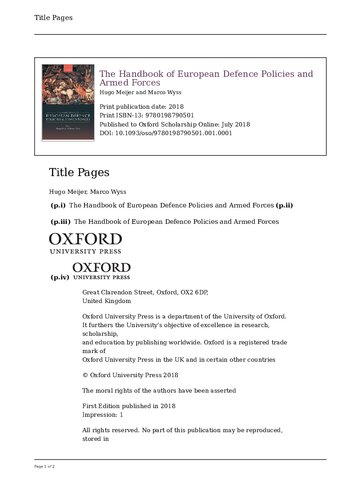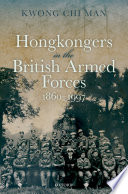The Handbook of European Defence Policies and Armed Forces 1st edition by Hugo Meijer, Marco Wyss 0192507753 9780192507754
$50.00 Original price was: $50.00.$25.00Current price is: $25.00.
The Handbook of European Defence Policies and Armed Forces 1st edition by Hugo Meijer, Marco Wyss – Ebook PDF Instant Download/DeliveryISBN: 0192507753, 9780192507754
Full download The Handbook of European Defence Policies and Armed Forces 1st edition after payment.

Product details:
ISBN-10 : 0192507753
ISBN-13 : 9780192507754
Author : Hugo Meijer, Marco Wyss
The armed forces of Europe have undergone a dramatic transformation since the collapse of the Soviet Union. The Handbook of European Defence Policies and Armed Forces provides the first comprehensive analysis of national security and defence policies, strategies, doctrines, capabilities, and military operations, as well as the alliances and partnerships of European armed forces in response to the security challenges Europe has faced since the end of the cold war. A truly cross-European comparison of the evolution of national defence policies and armed forces remains a notable blind spot in the existing literature. The Handbook of European Defence Policies and Armed Forces aims to fill this gap with fifty-one contributions on European defence and international security from around the world. The six parts focus on: country-based assessments of the evolution of the national defence policies of Europe’s major, medium, and lesser powers since the end of the cold war; the alliances and security partnerships developed by European states to cooperate in the provision of national security; the security challenges faced by European states and their armed forces, ranging from interstate through intra-state and transnational; the national security strategies and doctrines developed in response to these challenges; the military capabilities, and the underlying defence and technological industrial base, brought to bear to support national strategies and doctrines; and, finally, the national or multilateral military operations by European armed forces. The contributions to The Handbook collectively demonstrate the fruitfulness of giving analytical precedence back to the comparative study of national defence policies and armed forces across Europe.
The Handbook of European Defence Policies and Armed Forces 1st Table of contents:
1. Editors
2. Chapter Authors
Introduction: Beyond CSDP: The Resurgence of National Armed Forces in Europe
Reframing European Defence
A Glaring Imbalance: The Literature on the CSDP and National Armed Forces
Central Findings: Common Patterns versus Divergences
Part I National Defence Policies
Major Powers
1. France
Introduction
Defence Policymaking in a French Context
The Evolution of the Nuclear Doctrine
The Transformation of the French Armed Forces since 1991
Conclusion
2. Germany
Introduction
The Styles of German Defence Policy
German Security and Defence Policy
Foreign Deployments of the Bundeswehr
The Domestic Institutional Framework for Defence
The Reorganization of the Bundeswehr since 1990
Conclusion
3. The United Kingdom
Introduction
The Evolution of the UK Defence and Security Policy during the Cold War
UK Defence and Security Policy in the Post-Cold War World
Remaking National Security after Iraq and Afghanistan
Conclusions
4. Russia
Introduction
Upheaval: 1992–2000
Transition: 2000–2008
Revival: 2008–2012
Consolidation?: 2012–
Conclusion
Medium Powers
5. Italy
Introduction
Italian Defence Policy in the Post-Cold War Era
Strategic Documents and Domestic Reforms
Military Operations Abroad
The Evolution of Italian Defence Policy: Drivers, Enablers and Constraints
Conclusions
6. Poland
Introduction
Geostrategic Dilemmas
Strategic Choices after Communism_ NATO and the European Union
The Military Modernization Programme
Facing an Assertive Russia: NATO and the Return to Territorial Defence
Conclusion
7. Spain and Portugal
Introduction
Strategic Visions and Cultures
The Evolution of Defence Policies
The Financial and Industrial Bases
The Transformation of Force Structures
Missions, Operations, and Challenges
Partners and Frameworks for Cooperation
Conclusions
8. Turkey
Introduction
Military Strategy and National Security Priorities
Civil–Military Relations
Military Operations
Military Capabilities, Procurement, and Expenditure
Conclusion
9. Ukraine
Introduction
Non-Alignment between NATO and Russia (1991–2000)
Reforms and NATO Ambitions (2001–2009)
From Non-Aligned Status to Russian Aggression (2010–2016)
Lessons Learned and a New Conceptual Framework for Transformation
Conclusion
Lesser Powers
10. Austria and Switzerland
Introduction
Austrian and Swiss Security and Defence Policies
The Role of the Armed Forces
The Ways Ahead
Conclusion
11. Baltic States
Introduction
Safeguarding Reclaimed Sovereignty
Finding Shelter
Russia’s Resurgence
Conclusion
12. Belarus
Introduction
The Post-Soviet Geopolitical Context
Perception of Regional Security Challenges
The Structure of the Armed Forces
Conclusion
13. Benelux Countries
Introduction: Benelux, Pioneering European Cooperation
The Netherlands
Belgium
Benelux and Wider Defence Cooperation
Conclusion
14. Bulgaria and Romania
Introduction
From East to West: The Way to NATO and the EU
Comprehensive Reforms: Doctrinal and Force Transformation
Regional Cooperation: South-Eastern Europe and the Black Sea Region
Conclusion
15. Czech Republic, Hungary, and Slovakia
Introduction
Civil–Military Relations
Defence Policy and Threat Assessment
Modernization of Armed Forces
Participation in Military Missions Abroad
Nascent Defence Cooperation
Conclusion
16. Serbia and Croatia
Introduction
Serbia
Croatia
Conclusion
17. Greece, Cyprus, and Albania
Greece
Cyprus
Albania
Conclusion: An Assessment
18. Ireland
Introduction
The Defence Forces, 1924–1989
The Post-Cold War Period
The Defence Forces since 2000
Conclusion
19. Finland and Sweden
Introduction
Evolution of the Post-Cold War Threat Environment
Finland: Geopolitical Realities and Cold Nerves
Sweden: From National Defence to Crisis Management and Back Again
Defence Cooperation between Finland and Sweden
Relationship with NATO
Conclusion
20. Denmark and Norway
Introduction
Ends: Security and Defence Policy
Ways: Military Doctrines and Operations
Means: Force Structures
Conclusions
Part II: Alliances and Security Partnerships
21. The North Atlantic Treaty Organization
Introduction: Alliance Adaptation and Relevance
Theoretical Foundations on Alliance Cohesion and Adaptation
Back to the Future for European Forces and NATO Adaptation
Conclusion
22. The Common Security and Defence Policy
Introduction
The Emergence and Development of the CSDP
The Balkan Wars and the Coming of the CSDP
From the ESDP to the CSDP
Much Ado About Nothing?
Current Trends and Future Prospects
Conclusion
23. Organization for Security and Cooperation in Europe
Introduction
The Military Aspects of Détente: Trust through Transparency
The Crisis of the Conventional Arms-Control Regime in Europe
The Ukraine Crisis and Conventional Arms Control in Europe
Conclusion: Perspectives of Conventional Arms Control in Europe
24. UK–French Defence and Security Cooperation
Introduction
Genesis of the Treaties
Achievements and Evolutions since 2010
Conclusions: Evolution of the Partnership and the Challenges Ahead
25. Franco-German Defence and Security Cooperation
Introduction
Institutional Framework
Armament Cooperation
Different Nuclear Worlds
The Franco-German Brigade, Eurocorps, and National Forces
Missions, Operations, and Deployment
Conclusion
Part III: Security Challenges
26. Conventional Interstate Warfare
Introduction
Conventional Interstate Warfare
European Conventional Interstate Warfare, 1990–2016
Budgeting for Conventional Interstate Warfare
Conclusion: The Fog of Future War
27. State Failure
Introduction
European Realities
The Nature of State Failure
Political Goods and Failure
Overseas Security Issues
Conclusion
28. Transnational Terrorism
Introduction
Humble Beginnings: From al-Qaeda to the Islamic State
ISIS’s Evolving Strategy: Home and Away
ISIS’s European Designs: Connecting the Dots
Conclusion: Europe’s Long War Ahead
29. The Proliferation of Nuclear Weapons
Introduction: The Ongoing Threat of Nuclear Proliferation
Managing Proliferation in the ‘First Nuclear Age’: Arms Control and the NPT
Post-Cold War Vertical Nuclear Proliferation Challenges: The ‘P5’ NWS
Post-Cold War Horizontal Nuclear Proliferation Challenges: The Nuclear Outliers
Broader and Over-the-Horizon Nuclear Proliferation Challenges
Conclusion: Europe and the Global Nuclear Future
30. Cyber-Security Challenges
Introduction
The Fog of Cyber War
What Cyber Warfare Can Achieve
Cyber Security Challenges: From Stuxnet to Daesh
Conclusion
Part IV: Strategic and Doctrinal Responses
31. Land Warfare
Introduction
Continuities in Land Warfare
Intra-European Variation
Conclusion
32. Sea Warfare
Introduction
Structure and Methodology
Factors Underpinning European Naval Strategy
European Naval Capabilities Post-Cold War: Peace Dividend
US NATO and European NATO: Maritime Divergence
EU/NATO Divergence: Anti/Counter Piracy
A Changing Maritime Landscape
A New European Appetite?
The Strategy and Capability Conundrum
Conclusion
33. Air and Space Warfare
Introduction
Air Campaigns: Catalysts for the Transformation of European Aerospace Power
Building Blocks of European Aerospace Power
Conclusion
34. Counterinsurgency
Introduction
Counterinsurgency in Military Operations
Major European Powers and the Counterinsurgency Decade
Smaller Powers in Counterinsurgency
Conclusion: The Future of European Counterinsurgency
35. Counterterrorism
Introduction
The United Kingdom
Germany
France
Medium- and Small-Sized Powers
Conclusion
36. Non-Proliferation and Counter-Proliferation
Introduction
Major Powers and Non-Proliferation
Lesser Powers and Non-Proliferation
Conclusion
37. Intelligence
Introduction
Development
Constraints
The Contemporary Challenge
Conclusions
38. Cyber Defence
Introduction: The Cyber Paradox
Origins of the Cyber Threat
Europe Enters the Cyber Domain
Europe: A Central Theatre of Rivalry
Problems of Strategy: European Perspectives
Conclusion
Part V: Defence and Technological Industrial Capabilities
39. Arms Procurement
Introduction
The Dynamics of European Arms Procurement
National Sovereignty versus the ‘Cost of Non-Europe’
Conclusion
40. Defence Industrial Cooperation
Introduction
Explaining and Understanding Defence Industrial Cooperation
Defence Industrial Cooperation in Europe I: General Trends
Defence Industrial Cooperation in Europe II: Bi- and Multilateral Arms Projects
Governing the European Defence Technological and Industrial Base (EDTIB): Cooperation versus Competition
Conclusion
41. Arms Transfers and Export-Control Policies
Introduction
The EU’s Export-Control Regime
The Impact of the EU Regime on Member States’ Policies
A Slowdown in EU-Level Regime Formation
Conclusions
42. Nuclear, Chemical, and Biological Weapons
Introduction
Chemical and Biological Weapons
Nuclear Weapons
Conclusions
43. Emerging Technologies: Unmanned Aerial Vehicles
Introduction
Unmanned Vehicles
European Security and Unmanned Vehicles
Conclusion and Challenges Ahead
44. Cyber Capabilities
Introduction
Assessing Cyber Capabilities
Cyber Capabilities: Major European Powers
Cyber Capabilities: Medium and Lesser Powers
Conclusions
45. Space Capabilities
Introduction
European Space: An Overview
European Military Space Policy
Defining a Distinctive EU Security Space Policy
Multilateralism or Fragmentation?
Conclusions and Outlook for European Military Space Policy
Part VI: European Armed Forces in Action
46. French Military Operations
Introduction
Post-Cold War French External Operations
The Future of French Military Operations: Main Challenges
Conclusion
47. UK Military Operations
Introduction
The United Kingdom’s Forces at the End of the Cold War
From Cold War to Hot Policing
Operations Creep
Game Changer
Two Big Operations into One Small Force Don’t Go
UK Operations since 2010
A Future Force?
Conclusion: Ever-Decreasing Strategic Circles?
48. Russian Military Operations
Introduction
Russian Military Operations: Case Studies
Patterns in Russian Military Operations since the End of the Cold War
Conclusions
49. European Involvement in United Nations Peacekeeping
Introduction
Cold War Peacekeeping (1956–1989)
The Rise and Fall of Post-Cold War Peacekeeping (1989–1995)
Sporadic Engagement: European Military Involvement in UN Operations, 1999–2012
Mali: A Fresh Start?
Conclusion
50. CSDP Military Operations
Introduction
Emergence and Institutional Evolution
Features, Diversity, and Trends
Mandates, Achievements, and Challenges
Conclusions: Lessons, Implications, and Roads Ahead
51. NATO Operations
Introduction
Strategic and Doctrinal Change, 1990–2015
NATO Operations, 1992–2016
Burden-Sharing in the Post-Cold War Era
People also search for The Handbook of European Defence Policies and Armed Forces 1st:
the handbook of european structured financial products
the handbook of european intelligence cultures
the handbook of european fixed income securities
the handbook of european birds
the handbook of european welfare systems
Tags: The Handbook, European Defence, Policies, Armed Forces, Hugo Meijer, Marco Wyss
You may also like…
History - Latin American History
Latin American Soldiers: Armed Forces in the Region’s History 1st Edition John R. Bawden
Politics & Philosophy - Warfare & Defence
Politics & Philosophy
Politics & Philosophy - International Relations
The EU, Irish Defence Forces and Contemporary Security 1st Edition
History - Asian History
Hongkongers in the British Armed Forces, 1860-1997 Chi Man Kwong
Uncategorized
Politics & Philosophy - Politics
Integration and Differentiation in the European Union: Theory and Policies Dirk Leuffen
Hobbies & Games - Other Sports












